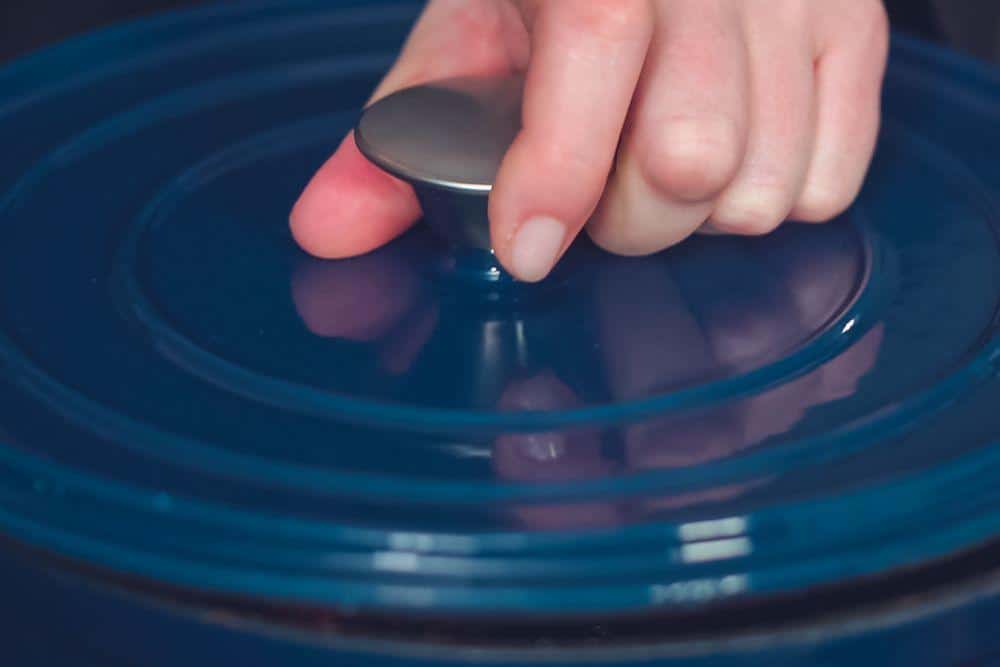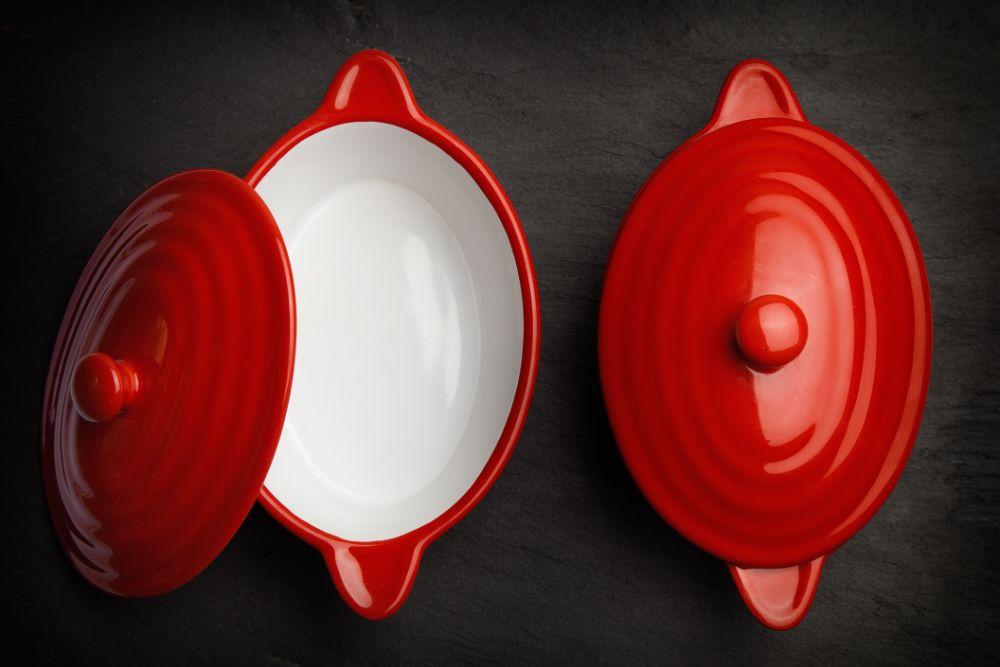Dutch ovens are true kitchen workhorses. This humble piece of cookware does almost everything: you can simmer, roast, boil, steam, fry, saute, braise, and even deep fry. But what makes it so versatile is that it can go from the stovetop to the oven. You can even use these tools for baking!
But what about the lid? Can you put a Dutch oven lid in the oven? This question is logical for anyone who wants to use their pot in the oven. Today, we’re going to cover everything you need to know.
So what’s the verdict? Can you put a Dutch oven lid in the oven? Is it safe? The answer is probably. But before you do, it’s essential to check what material the lid is made of. Many Dutch oven lids are made from the same materials as the pot in which case, you can put them in the oven without worry.
Le Creuset Shows that Stove to Oven is Possible for Their Dutch Ovens - Just Make Sure Your Lid and Knob Can Withstand Oven Heat
Yet many manufacturers use different materials for their knobs or handles. If your pot is like this, you should consult the maximum temperature the lid can withstand. In most cases, the lid is oven safe to about 400 degrees Fahrenheit. You’ll need to take care to stay below this temperature.

Knobs or Handles on a Dutch Oven Lid May or May Not Be Dishwasher Safe
Before you worry, manufacturers know that most people use Dutch ovens for slow cooking. Even if it’s not completely oven-safe, the lid will still be able to handle relatively high temperatures--what most people need from their pots.
If you do need to reach higher temperatures, many less heat-resistant models allow you to remove the knob. This way, you can use the lid in the oven without worry.
You’re probably curious whether your particular Dutch oven lid can safely go in the oven. Let’s look at some common lid materials and how heat resistant they are.
There’s a reason cast iron cookware is the gold standard for Dutch ovens: it’s incredibly heat resistant (among other amazing properties it has). A cast iron Dutch oven can tolerate a high temperature of up to 500 degrees Fahrenheit, making them completely oven safe.
It is critical to know what kind of cast iron you have. Enameled cast iron tolerates high temperatures a bit less than cast iron. Still, these lids can go in the oven with no issue.
After cast iron, stainless steel is the next safest choice. As long as your lid is one hundred percent stainless steel, it’s completely oven safe. This impressive material tolerates temperatures of up to 500 degrees Fahrenheit.
Glass makes people nervous, and with good reason. The consequences of shattered glass can be devastating, so any accidents are best avoided.
But rest assured, your glass cookware is quite heat resistant. Most glass Dutch ovens can handle temperatures up to 400 degrees Fahrenheit. Tempered glass (like Pyrex and corning ware) fares even better.
What you should keep in mind is that glass doesn’t respond well to extreme temperature fluctuations. Individual manufacturers may have more specific recommendations, but always make sure the oven is preheated and avoid any abrupt temperature changes.
You can’t go wrong with ceramic lids. Like stainless steel and cast iron, this material is incredibly heat resistant. It can handle temperatures of up to about 500 degrees Fahrenheit. The one caveat is that the entire lid must be ceramic. Some manufacturers prefer mixed-material lids, so check to be sure.
Ceramic is similar to glass because it doesn’t handle extreme temperature variations well. To avoid cracking, take care not to change from cold to hot temperatures too rapidly.
Aluminum is a less popular material choice for Dutch ovens, but it tolerates heat well. Aluminum lids can handle up to about 400 degrees Fahrenheit.
If you plan to use your Dutch oven in the oven (which is a relatively safe bet), it’s critical to check that your lid is oven-safe. Even the best Dutch oven may not have an oven-safe lid. So how do you check?
This information is easy to find if you’re purchasing a new Dutch oven. The box should contain instructions regarding oven safety.

While This Lid and Knob are Made From the Same Materials as the Dutch Oven, You’ll Still Want to Refer to Manufacturer Instructions to Make Sure The Lid is Oven Safe
If your Dutch oven isn’t new or you no longer have the instructions, examining the cookware itself can yield vital clues. Most manufacturers put oven safety information at the base of the pot.
Look for a symbol of a box with bowls or plates on it, which means your Dutch oven lid is completely oven-safe. Conversely, you might find a symbol of a box with a temperature in it. This temperature indicates how ovenproof the cookware is.
It’s always best to heed the manufacturer’s temperature warnings to avoid damaging your Dutch oven.
You may find that your Dutch oven has no information on it. In this case, try checking the manufacturer’s website. It’s helpful to have the make and model on hand, as some models may have different heat tolerances.

A Dutch Oven With a Different Type of Knob or Lid Material May Not be Oven Safe
Unfortunately, in the case of older Dutch ovens, locating this information may prove more challenging. If the above strategies don’t work, examine the material of your cookware. Doing so should provide clues about how oven-safe it is. You can usually put cast iron and stoneware in the oven without worry.
Given the high quality of Le Creuset Dutch Ovens, you’d probably assume you can put Le Creuset oven lids in a conventional oven without any problems. Indeed, the brand claims that you can use them in the oven.
This fact is true--up to a point. Upon closer inspection, we can see that the knobs on the lid are only oven safe up to 375 degrees Fahrenheit. For most people, this won’t be an issue. It’s only something to be aware of if your recipe calls for higher temperatures. Some Dutch oven cooking does, most notably if you’re making no-knead bread.
If you find yourself in a high-heat situation, the best way to proceed is by removing the knob. Simply flip the lid over, grab a screwdriver, and remove the screw holding the knob in place.
Some people prefer to replace the knob altogether. Le Creuset sells phenolic Dutch oven replacement knobs that are safe in temperatures of up to 500 degrees Fahrenheit. They also sell metal ones that can handle essentially any temperature your oven is capable of reaching. This way, you can forget about screwing and unscrewing the knob.
What happens if you accidentally warp your lid’s knob? You wouldn't be the first. Luckily, as Le Creuset does, most brands sell replacement knobs. They’re more heat resistant than the ones on some Dutch ovens. You may even want to purchase a replacement knob right from the start to avoid any headaches in the future.
Aside from giving you peace of mind, replacement knobs allow you to customize your gorgeous Dutch oven even further. Le Creuset stands out for its stunning gold, copper, and stainless steel knobs. On the other hand, Staub mixes things up with fun animal-shaped knobs made from nickel-plated brass. You’re sure to find something practical that also fits your aesthetic.
And of course, the replacement knobs are available in different sizes. Some people find adjusting the knob size makes a difference in their comfort.
Don’t preheat an empty pot. Preheating it empty can make the enamel crack, so ensure you add oil before turning on the stove.
Preheating time varies depending on the size of the pot. The best practice is to allow it to preheat for around fifteen to twenty minutes.
If you’re making no-knead bread, the same principle applies. Deep-bottom Dutch ovens need around an hour in the oven at 450 degrees Fahrenheit to reach the right temperature. Put your empty pot into a cold oven, and let the two slowly come to temperature together.
Avoid high heat. Some people like to put their pots on the stove and crank the heat up high. However, it’s best to avoid doing so. A too-hot stove can damage the pot and your food.
Ditch the lid. You shouldn’t preheat your Dutch oven with the lid. You might create an accidental build-up of pressure.
A final word on enameled cast iron; while it doesn’t require the same preheating on the stove, it can be useful to preheat them in the oven. Follow the same tip listed above for no-knead bread.
A final word on enameled cast iron; while it doesn’t require the same preheating on the stove, it can be useful to preheat them in the oven. Follow the same tip listed above for no-knead bread.
